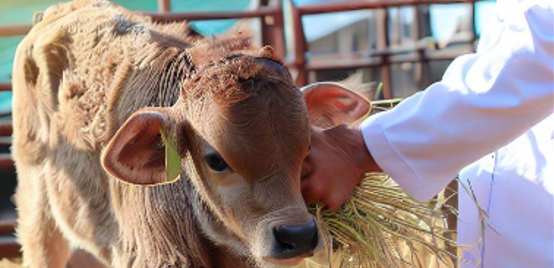CALF TUBE
2023-08-17

Begin by assessing health with temperature, heart rate, and respiratory rate. Have you ever noticed that even a calf you know is sick temporarily perks up when you approach it? Since cattle are a type of prey, they do their best to not appear sick or vulnerable, even when they don't feel well.
Therefore, it's important to catch sick animals early in the disease process and go beyond visual assessment, having an objective and consistent method to assess calf health. Evaluating basic vital statistics for each calf fits into this method. To measure a calf's vital signs:
TEMPERATURE: 37.7°C - 39°C Use a digital thermometer, much faster and safer than the old mercury type, to take rectal temperatures.
HEART RATE (Pulse): 100 - 140 BEATS PER MINUTE Calves typically have heart rates (pulses) twice that of adult cows. An irregular heartbeat could indicate illness. Pulse rate can be manually measured by placing two fingers over an artery. Arteries are easily accessible at the base of the tail and under the jaw. In severely ill calves, a weak pulse that's hard to detect might be present. In such cases, measure the heart rate by placing a stethoscope behind the calf's left elbow and against the chest wall. Remember that calf heart rates tend to increase when calves move or are highly active, so try to measure the resting heart rate for an accurate assessment.
RESPIRATORY RATE: 36 - 60 BREATHS PER MINUTE Step back a bit from the calf and observe the rise and fall of the body cavity to assess breathing. Do not place your hand near the calf's nose or mouth to assess breathing since smells or attempts to nurse can alter breathing patterns. Respiration can also be assessed using a stethoscope to listen for lung sounds and detect abnormalities like wheezing. High respiratory rates often accompany fever as animals attempt to cool themselves.
Elevated ambient temperature (25.5°C or higher), especially combined with high humidity, can cause all vital signs to increase naturally as the calf tries to control its body temperature. In such situations, calves may not necessarily be ill, but they definitely require measures to reduce heat stress, such as shade, water, mist, and fans.
To be prepared to assist sick or stressed calves, it's recommended to have the following tools at hand:
Stethoscope
Thermometer
Oral electrolytes to address dehydration
Probiotics to improve gut microbes and health
Nutrient-rich feeds for supporting calves that may have lost excessive nutrients and/or been away from feed
Additional B vitamins to support appetite, metabolism, and efficient energy production
"Using these tools and products poses very little or no risk when it comes to calf health and can even assist in supporting sick calves."